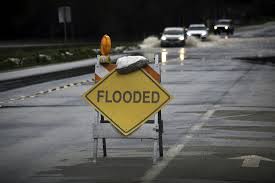LISTEN TO TLR’S LATEST PODCAST:
Should we, through government, encourage rebuilding major population centers in the most high risk areas of the country? Especially in areas that are prone to hurricanes, which are more predictable and frequent than earthquakes near fault lines, less random than tornadoes, and not minimized rather than maximized by development itself like some dangers such as wildfires.
Or is that guaranteeing that more lives and property will be put at risk continually moving forward?
As of this writing, Hurricane Irma has yet to hit the U.S., and one can only imagine the kind of devastation that may come. We have some educated guesses, of course, especially of what the worst case scenarios may look like. Worst case being, of course, a direct hit to Miami when the hurricane is at it’s peak. Miami is densely populated, and built up enough to have eroded some natural flooding barriers like many of the surrounding everglades, similar to Houston’s expansion over prairies. These natural barriers were able to absorb some flooding in a way that concrete and buildings cannot.
It’s no secret why many major population centers in our nation have clustered around the coasts. New York, Philadelphia, and Boston were long major hubs accepting European ships which populated our country and drove out the native population. Many coastal cities in California receive Chinese goods while offering beautiful beaches… think L.A., or any of the Sans– Diego, Jose, or Francisco. Houston is near gulf oil refineries, New Orleans sits at the mouth of the Mississippi, and Miami has always been a hub to the Caribbean and South America.
Obviously, not all major cities are near the coasts. Chicago and Milwaukee sit inland from the Great Lakes, sitting in the Midwest yet able to ship all the way to the Atlantic. There are areas that wouldn’t even be possible for human beings to live in without technology like advanced canals, such as Phoenix or Vegas. There’s plenty of inland areas settled due to discoveries of oil or gold that have merely stuck around once they were well enough built up, such as Dallas/Fort Worth. In terms of population growth, ten of the fifteen fastest growing cities are inland Texas, from smaller cities like Frisco and McKinney, to larger hubs like Austin that are stealing the best computer geeks and engineers from places like Silicon Valley.
But just because there were plenty of good reasons to settle major population areas near the coasts when our country was young, does that mean there are still good reasons to stay? Sure. For one, there’s the convenience and comfortability of the community many residents are a part of, and residents often remain for less anywhere. Oceanfront property has always been attractive for aesthetic reasons alone. Many industries that rely on ocean access still exist.
However, how many people in these cities are directly involved in shipping, immigration, tourism, offshore drilling, fishing, and the like, and how much of an indirect population is needed to serve that base? How many people are there merely because population centers have high birth rates, and many people never move when they’ve grown up connected to the community? How many would still stay if insurance rates in coastal areas priced them out of the market while they weren’t subsidized by the national flood insurance program (NFIP)?
Claiming the NFIP puts lives at risk may be entirely true, but I’ll admit to the weakness of trying to turn an economic argument into an emotional one. Human beings are portable and resilient. Americans live to an average of nearly eighty years old, and even in coastal regions, natural disasters aren’t anywhere near the top of the list. The main killers in such areas are the same as elsewhere in America… abortion, followed by heart disease, followed by cancer, followed by respiratory disease.
However, the property of, well… property… is easily the top of the list of nearly every homeowner’s top investment. Housing is the one thing we need to survive that isn’t disposable (such as food, water, or air), and in modern society with our expansive population with limited space, in many ways irreplaceable even with the ability to rebuild. The choice of house is one of the biggest life decisions most people make outside of children. The location that home is in has huge consequences for the homeowner’s family, and when talking about mass settlements, their community as well.
There’s an easy way to determine the answers to these questions, and that’s price structure. These coastal areas have plenty of natural beauty to offer, which is incredibly hard to quantify. Is living on oceanfront property worth the risk? Given value is subjective and beauty hard to quantify, I’d say that’s for those rich enough to afford to to determine with their own money.
The NFIP misallocates resources by removing some risk consideration from insurance in participating counties. It encourages building (or staying) in participating counties in flood plains and hurricane prone zones, by removing some price constraints on the practice in participating counties. In short, it encourages building (or staying) in at risk areas that are dangerous for owners, renters, and the properties themselves. There are people who have rebuilt the same home in the same location dozens of time through use of the NFIP, and repetitive-loss claims have cost the program $200 million a year.
Many of the cities near the cost would exist without such perversion of incentives… after all, humans are notoriously bad at assessing long term risk/reward calculations in a way they aren’t with more immediate considerations. Some economic activity is inexorably linked to ocean access, which would encourage such living environments without the subsidy of the NFIP. But it’s doubtful that the clusters of population would be nearly as pronounced without such guarantees and prices that undercut the actual insurance market.
This isn’t even an unintended consequence of the program. It’s the whole point. Through the NFIP, certain homeowners are allowed to buy “insurance” at a rate which is not set through market risk evaluation. This was done as a response to flood insurance in high risk areas becoming so prohibitively expensive that most could not afford it, because it seemed to some as an unfair exploitation of owners (and by extension, renters) by insurance companies. In reality, insurance companies which are better at assessing long-term risk were offering price signals to humanity about what long-term risk coastal properties actually presented. Instead of allowing such information to inform property owners in an immediate way, government chose to dilute such signals, putting at risk people and property in areas which have become only more intractable as a result.
The NFIP isn’t just ineffective at the goal of “helping” while taking the long view, it’s counter-productive and harmful. The NFIP puts at risk lives, property, and stability for large swaths of Americans all in the name of fairness and compassion.




3 comments
… [Trackback]
[…] Read More Info here to that Topic: thelibertarianrepublic.com/nfip-risks-lives-property-stability-name-compassion-2/ […]
… [Trackback]
[…] There you will find 45313 additional Information on that Topic: thelibertarianrepublic.com/nfip-risks-lives-property-stability-name-compassion-2/ […]
… [Trackback]
[…] There you can find 5752 more Information on that Topic: thelibertarianrepublic.com/nfip-risks-lives-property-stability-name-compassion-2/ […]